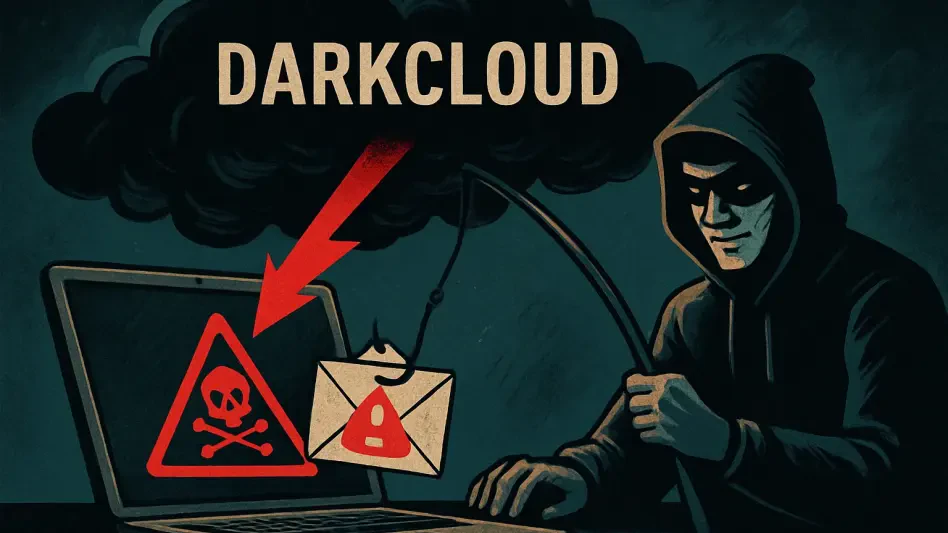What happens when a single click on an email attachment unleashes a silent predator that steals passwords, credit card details, and personal data without raising a single alert? This is the stark reality of DarkCloud, a cunning infostealer malware that hides in plain sight using advanced obfuscation techniques. In today’s digital landscape, where phishing attacks are a daily menace, this threat represents a chilling evolution in cybercrime. By leveraging ConfuserEx, an open-source tool for obscuring .NET applications, DarkCloud evades traditional defenses with alarming precision. This feature delves into the shadowy tactics of this malware and the urgent need to adapt security measures to combat such stealthy adversaries.
The Silent Epidemic of Obfuscated Malware
In an era where data breaches cost businesses billions annually, the rise of obfuscated malware like DarkCloud underscores a critical vulnerability in cybersecurity. Infostealers are no longer just opportunistic threats; they are meticulously engineered to bypass static detection methods that many organizations still rely on. With phishing emails as their primary delivery mechanism, these attacks exploit human error to infiltrate systems, often targeting sensitive information that can be sold on the dark web. The significance of this issue cannot be overstated—reports indicate that credential theft via malware has surged by over 60% in the past two years, highlighting the scale of the problem.
Understanding the broader implications of this trend reveals why traditional antivirus solutions are struggling. Obfuscation tools like ConfuserEx allow cybercriminals to mask their code, rendering signature-based detection nearly obsolete. As a result, both individuals and enterprises face heightened risks of data loss, financial damage, and reputational harm. This growing challenge demands a shift in focus toward dynamic, behavior-based defenses to keep pace with ever-evolving threats.
Peeling Back the Layers of DarkCloud’s Stealth
DarkCloud’s ability to remain undetected rests on a sophisticated arsenal of evasion tactics, primarily powered by ConfuserEx obfuscation. The attack often begins with a deceptive phishing email containing compressed attachments such as TAR, RAR, or 7-Zip files. These attachments harbor obfuscated JavaScript or Windows Script Files that, once executed, retrieve malicious PowerShell scripts from remote servers, ultimately deploying the ConfuserEx-protected payload written in Visual Basic 6.
ConfuserEx itself employs a range of techniques to obscure the malware’s code, including renaming classes and methods to random non-ASCII symbols, flattening control flow with opaque predicates, and using proxy call methods to disguise functionality. Additionally, anti-tampering protections ensure that encrypted code is only decrypted at runtime, while tactics like process hollowing allow DarkCloud to hide within legitimate processes such as RegAsm.exe or MSBuild.exe. Such layered defenses make reverse-engineering a daunting task for analysts.
Beyond these core methods, DarkCloud demonstrates remarkable creativity in concealing its payload, as seen in variants that use steganography to embed malicious code within JPEG images hosted on platforms like the Internet Archive. Encrypted strings using RC4 and 3DES algorithms further secure its command-and-control communications, ensuring stolen data—ranging from browser credentials to email contacts—is exfiltrated via protocols like FTP or SMTP without detection. This multi-faceted approach positions DarkCloud as a formidable foe in the malware landscape.
Voices from the Frontlines: Analysts Weigh In
Cybersecurity experts have sounded the alarm on DarkCloud’s advanced use of ConfuserEx, pointing to its implications for the industry. Researchers at Palo Alto Networks Unit 42 have described this infostealer as a prime example of why static analysis tools are increasingly ineffective against modern threats. Their analysis emphasizes the need for proactive, behavior-based detection systems that monitor runtime activities rather than relying on outdated signature databases.
Fortinet’s FortiGuard Labs has also documented unique attack chains associated with DarkCloud, including the use of steganography to hide payloads in seemingly innocuous images. A cybersecurity analyst from Unit 42 remarked, “The rapid adaptation of evasion techniques by threat actors behind DarkCloud shows just how critical it is to evolve beyond traditional defenses.” This sentiment is echoed across the field, with experts urging organizations to prioritize real-time monitoring and anomaly detection to catch such stealthy malware in action.
Their insights reveal a consensus: the adaptability of infostealers like DarkCloud necessitates a fundamental rethink of security protocols. As cybercriminals refine their methods, the gap between attack sophistication and defense capabilities widens, pushing the industry to innovate at an unprecedented pace. These expert perspectives serve as a stark reminder of the urgency to stay ahead of evolving threats.
Armoring Up: Strategies to Thwart DarkCloud’s Tricks
Confronting a threat as elusive as DarkCloud requires a multi-pronged defense strategy that addresses both prevention and detection. One of the most critical steps is fostering email vigilance among users—training programs should focus on identifying phishing attempts and avoiding suspicious attachments like compressed files. By reducing the likelihood of initial infection, organizations can significantly lower their exposure to such malware.
For technical defenses, leveraging specialized tools to dismantle ConfuserEx obfuscation is essential. A structured approach, as outlined by security researchers, includes using utilities like AntiTamperKiller to disable anti-tampering mechanisms, followed by de4dot-cex to decode obfuscated symbols and ProxyCall-Remover to expose hidden method calls. Additionally, deploying endpoint detection and response systems that analyze runtime behavior can help identify anomalies such as process hollowing, a common tactic employed by DarkCloud.
Network-level monitoring also plays a vital role in mitigating this threat. Keeping a close watch on outbound traffic for unusual connections to open-directory servers or known command-and-control channels can disrupt data exfiltration attempts. By integrating these practical measures—spanning user education, technical countermeasures, and continuous monitoring—organizations can build a robust shield against DarkCloud and similar obfuscated infostealers, turning the tables on cybercriminals.
Reflections on a Battle Fought
Looking back, the fight against DarkCloud infostealer revealed just how far malware creators have advanced in their quest for invisibility. The intricate use of ConfuserEx obfuscation stood as a testament to their ingenuity, challenging even the most seasoned cybersecurity defenses. Each layer of deception, from phishing emails to steganography, was meticulously crafted to exploit gaps in traditional security frameworks.
Yet, this struggle also illuminated pathways forward that went beyond mere reaction. Adopting behavior-based detection has proven to be a game-changer, offering a way to spot threats in real time rather than after the damage is done. Strengthening user awareness around phishing tactics has similarly reduced the risk of initial breaches, while specialized tools provided a means to unravel even the most complex obfuscation.
As the dust settled, it became clear that ongoing vigilance was non-negotiable. Investing in advanced monitoring systems to track network anomalies promises to catch future variants before they strike. Encouraging collaboration across industries to share threat intelligence also emerged as a key step, ensuring that lessons learned from DarkCloud fortify collective defenses against the next unseen predator lurking in the digital shadows.








